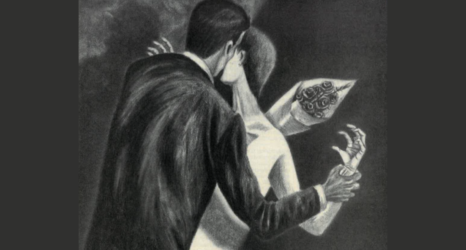The pretty pathway that runs along Waller Creek is a quiet spot, just steps away from the bustle of campus traffic at the University of Texas at Austin. These days, the air around the place feels heavy, a weight that saturates the creek’s stone banks and leafy canopy overhead. It is not uncommon to see students staring into the water, lost in thought. They pause by faded cloth flowers left at a small sculpture of a woman and two children. They glance a scrap of yellow tape, once heeding caution, which lies partly buried in its bank. They are caught off guard by signs that now block the path and announce the creek’s renovation.
Trees will be cut to allow the light in, the banks cleared. For the sake of safety and sustainability, we are told. It’s going to be great, we are told. A poster, one of a series now found all over campus but concentrated here, depicts a feminine face looking to the sky. As she lowers her cellphone, she calls on us to “be aware of our surroundings,” to “be safe.”
The April 2016 murder of second-semester dance and theater major Haruka Weiser at Austin’s Waller Creek was, and remains, a tragedy of unspeakable proportions. And yet, we must see this killing as part of the far more pervasive and largely unrecognized work of violence. Recognizing this is central if we are to more effectively respond to fight against it.
The creek surfaced in the news when Weiser’s body was found along its shores. She was attacked as she cut down along the creek path, perhaps seeking, as many of us do, a moment of quiet after her busy night. Grainy surveillance tape depicts the moment she headed under its canopy and was gone. In the days that followed, the story of the creek and its murder slipped into one of those deeply entrenched, recycled narratives of violence against women: A young girl, beautiful and talented, with hopes for a future in medicine. Her alleged attacker, a stranger, black, homeless, stalking the streets, up to no good. The theater of violence a public space, innocuous by day, filled with threat once cloaked by nightfall. A rare and spectacular attack in an otherwise safe campus and city community.
This is the so-familiar and seductive account told and retold in reports that make the news, sell movies, drive political debates and shape the stories we tell our loved ones and ourselves about how violence happens. But we must excavate the layers of power that lie, sedimented like the creek’s mineral deposits, beneath the surface.
On the cusp of an adulthood filled with opportunity, Weiser was excited to be recruited by our university, to join a community where she should expect to be safe, day or night, wherever she chose to walk. Instead the fact of campus life is one where violence against women remains both breathtakingly common and largely ignored. A 2015 campus climate report showed 18.5 percent had been sexually assaulted since entering college; 10.5 percent in the 2013-2014 year alone. Eight percent of female students had been sexually penetrated without their consent.
This violence is mirrored nationwide. According to the National Sexual Violence Resource Center, one in five women and one in 16 men are sexually assaulted by the time they finish college. Up to 90 percent of assaults against college women are committed by known perpetrators and 90 percent will go unreported. This victimization is also elevated for disabled people, people of color and the LGBTQ community. Gay and bisexual men are 10 times more likely to experience sexual assault than straight men, and one in four transgender students report being sexually assaulted since they enrolled at college. Feminist geographer Rachel Pain has called this pervasive, entrenched and normalized violence an “intimate war,” one that bridges public and private aggressions, those of the battlefield and the bedroom, the street and the dorm room.
And then the alleged attacker, a teen himself. His, a childhood of violence that complicates, while never excusing, the atrocity of this violent act. Troubled by a history of mental health problems, a childhood spent in and out of foster care, homeless, struggling with poverty. A life, in part, shaped by decades of racial segregation and marginalization, retrenchment of social supports, the stigmatization of and disinvestment in mental illness, the criminalization of homelessness. These violences are protracted, but in June 2016 alone, federal cuts to the U.S. Dept. of Housing and Urban Development devastated local services for the homeless. Our university is implicated in this violence, too, as our campus development encroaches on our neighboring communities, primarily black and Latino, driving urban change and, along with it, dispossession and housing insecurity.
When we only look at the surface of violence, deforesting the creek’s banks and a self-disciplining poster campaign seems a doable, immediate, affordable fix. They symbolize some kind of institutional response, they may empower those of us who feel vulnerable to feel protected, safer. And even if we do recognize the causes of violence are deeply and historically entrenched, we may feel paralyzed to respond. Then, felling trees and calls to lower our cellphones, walk with friends, feel like something. But such a response may also work to reproduce and enable the very violence it claims to challenge; by making those most vulnerable to violence responsible for their protection, by eliding the fact that most sexual violence happens not in public places like the street but in our dorms, kitchens and bedrooms, and by strengthening in our minds the image of the perpetrator of violence as society’s other rather than society’s self: our siblings, parents, students, employers and co-workers.
How, then, to respond?
At UT Austin, the Institute on Domestic Violence & Sexual Assault is conducting a four-year research study with 1,200 freshmen. This aims to better understand the extent and impact of intimate and interpersonal violence and will help us achieve a more accurate accounting of its pervasive reality during college years. This is complemented by diverse student organizing by groups like Voices Against Violence who are fighting systemic roots of violence through innovative theater-based educational efforts, counseling toward “healthy masculinities,” and annual survivor speak outs. These efforts, like those on campuses nationwide, must be matched by our own recognition and rejection, as individuals and as university, state and national leaders, of our pervasive culture of violence.
The life of Waller Creek is fleeting. Formed from springs that surface north of campus, it meanders for just seven miles through the lives of those that live and work in the city, ending its journey in the wide expanse of Lady Bird Lake. But it is fed from and feeds a deep and expansive aquifer, created over eons, that while largely unseen indelibly shapes the lives of our community. So, too, is violence in our community fed from a deeper source.
Clearing trees along its bank, a concrete act to reshape the landscape and thus restore security, and a poster campaign that lays the blame with the victim overlook this reality. At worst, these actions reproduce myths of violence that enable it to persist and continue.





